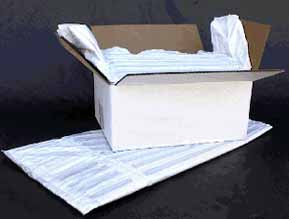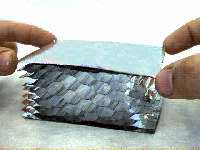|
An inexpensive, advanced insulating material developed by Berkeley Lab
researchers has been licensed by San Diego start-up Cargo Technology Inc.
for use as a thermal packaging to ship perishable cargo such as seafood,
meat, fruit, prepared foods and pharmaceuticals.
 |

AIRLINER PACKAGING TRANSFORMS A CARDBOARD BOX INTO AN INSULATED
COOLER
|
The Cargo Technology product, AirLiner, is an inflatable, insulating
bag that converts an ordinary corrugated box into a cooler to keep
perishables cold and fresh during shipping. AirLiner can be inflated with
ordinary air or to further prolong its thermal performance, with inert
gases.
Cargo Technology says the markets for insulated packaging materials for
shipping perishable cargo by air are growing and estimated at about $500
million annually. The company says that about 5.5 billion pounds of
perishables are shipped by air without refrigeration annually in both the
U.S. domestic and import/export markets in nearly 100 million containers.
Currently, most of these shipments are kept cold in expanded
polystyrene foam containers. Polystyrene is 30-year-old technology that is
bulky, cumbersome and prone to cracking and leaking.
AirLiner is produced from plastic films with internal baffles that
create a construction that inhibits heat transfer. AirLiner can be
transported to shippers in flat, space-efficient packages, saving
warehouse space and delivery expenses for shippers who use foam boxes.
About 50 AirLiner bags fit into the space now taken by only one similarly
sized foam container. The bag is inflated using a nozzle.
Researchers in Berkeley Labís Environmental Energy Technologies
Division developed the gas-filled panels used in Airliner back in the
1980s as a spin-off of research on superwindows. Superwindows are double-
or triple-paned energy-efficient windows with infrared-reflective (low
emissivity) coatings and inert gases filling spaces between panes for
extra insulation capacity.
The gas-filled panel technology was developed and patented at Berkeley
Lab, and extensively tested at Oak Ridge National Laboratory to confirm
its insulating performance. Since then, these panels have been used as
thermal insulation in a variety of applications, notably in studies of
prototype energy-efficient cars and appliances, and as a potential
insulating material in building construction.
 |

A CROSS-SECTION OF A PANEL REVEALS THE ALUMINIZED, BAFFLED,
HONEYCOMBED CONSTRUCTION
|
Gas-filled panels are made of multiple, honeycombed layers of thin,
aluminized plastic filled with a gas, either air, or an inert gas: argon,
krypton or xenon. The insulating value of the panel depends on which gas
is used as a fill -- it ranges from R-5 per inch (air-filled) to R- 20 per
inch (xenon-filled). By comparison, fiberglass insulation for buildings is
rated at about R-4 per inch. In 1991, gas-filled panels won the Grand
Prize for Home Technology in Popular Science's "Best of What's
New" awards.
"We are hopeful that this market success will motivate others in
the building and appliance field to look again at this promising, high
performance insulation technology," says Stephen Selkowitz, Head of
the Lab's Building Technologies Department.
In the early 1990s, the U.S. Department of Energy co-funded gas-filled
panel development with California state utility funds managed through the
California Institute for Energy Efficiency.
Additional information:
|


